
- Home
- Age
- Brand
- American Art Decor (14)
- Antique (12)
- Coca Cola (11)
- Coca-cola (11)
- Dechane's (9)
- Esso (16)
- Firestone (14)
- Goodyear (13)
- Handmade (21)
- Madura Coats Treads (11)
- Michelin (8)
- Mobil (13)
- Mobil Oil (11)
- Ovaltine (7)
- Samurai (44)
- Shell (10)
- Signs By Jake (11)
- Texaco (17)
- Unknown (19)
- Winchester (27)
- ... (4556)
- Features
- 3d Effect, Led (8)
- Antique (3)
- Blow Mold (2)
- Decorative (5)
- Embossed (5)
- Embossed, 3d Effect (2)
- Framed (376)
- Framed, Signed (13)
- Gallery Stamps (2)
- Hand Painted (3)
- Handcrafted (3)
- Handpainted (9)
- Irregular Nails (5)
- One Of A Kind (ooak) (70)
- Reclaimed (27)
- Reclaimed, Salvage (8)
- Salvage (5)
- Signed (143)
- Unframed (73)
- Vintage (4)
- ... (4089)
- Material
- Type
- Acoustic (9)
- Baskets (9)
- Bowls (11)
- Boxes (46)
- Furniture (14)
- Kitchen Equipment (25)
- Marquee Sign (13)
- Metal & Ironwork (31)
- Painting (191)
- Paintings (14)
- Plaque (20)
- Plaques / Signs (18)
- Pottery (13)
- Print (22)
- Sculpture (13)
- Sign (50)
- Signs (76)
- Street Sign (19)
- Tools (11)
- Wooden Sign (9)
- ... (4241)
- Year
Antique CARLING BREWING COMPANY BLACK LABEL ON TAP NEON BEER SIGN LIGHT old VTG
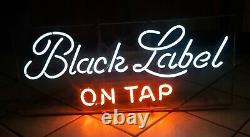

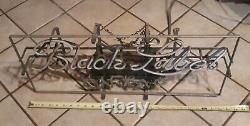
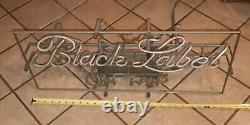
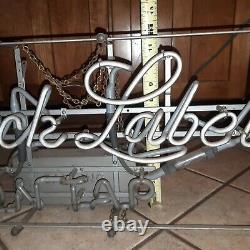
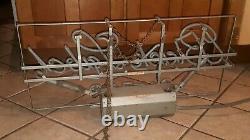

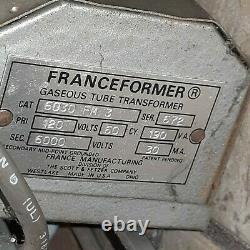
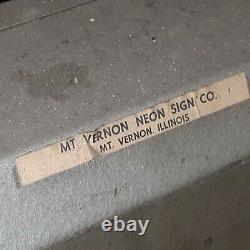
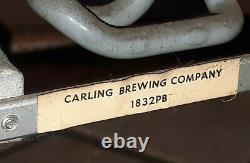


Antique CARLING BREWING COMPANY BLACK LABEL ON TAP NEON BEER SIGN LIGHT old VTG. Approx 26" long and 12" high. Carling Black Label Brewed since 1926 using a slow fermentation process and top-quality ingredients. CARLING BLACK LABEL is a light, clean-tasting blond lager with a subtle hint of hops.
Carling story dates back to 1818 when Thomas Carling, a farmer in England's Yorkshire district, took his family to the rich farmlands of eastern Canada settling at what is now the city of London, Ontario. During his first year there Tom Carling cleared a small area. Then, in accordance with the custom of the day, he called on his neighbors to help at a "stumping bee", a cooperative effort in which each man brought his own oxen and tools and the land was cleared of tree stumps.
All that these helpful neighbors asked was that they be refreshed and fed. Thomas Carling Thomas Carling's refreshment, a home-brewed ale, was of such quality that soon he was brewing it for other stumping bees.In time, it grew so popular that he abandoned farming for full-time brewing. The first Carling brewery was a modest affair - a couple of kettles, a horse to turn the grinding mill and six strong men to work on the mash tubs. He started by trundling his wares through the streets of London on a wheelbarrow.
This was the humble beginning of what was to become a worldwide brewing organization. Tom Carling established the brewing company that bears his name in London in 1840 London Brewery London Brewery after fire By 1878 when his sons, John and William, built a new six-story brewery in London, Carling was a national name in Canada. The new brewery was destroyed by a fire just a year after opening. William Carling, after fighting the fire and losing the battle, died of pneumonia shortly after the fire.The Carling line of brands was brewed under license. Carling is produced by them until 1911 and wouldn't be seen in the US until after prohibition. The opportunity for Carling's appearance on the American scene in 1933 was created by a combination of the Repeal of Prohibition, the deepening of the Great Depression and the desire of some American businessmen, led by James A.
Bohanon to venture into new fields. When the "dry" era ended the building that was to become Carling's Cleveland brewery was the home of the Peerless Motor Car Company, makers of prestigious custom-built cars. In the depressed economy of the day there was little demand for the expensive Peerless product. Looking for a new business opportunity, Peerless management decided to take advantage of what they saw as the imminent rebirth of the long dormant American brewing industry.
For help in entering this new field Peerless turned to Carling of Canada, an established brewer with a long and distinguished history. Technicians and brew masters were sent from Canada to convert the auto plant into a brewery and to train American personnel to operate it as the Brewing Corporation of America. The Brewing Corporation of America tried at first to just brew Carling's Red Cap Ale, but sales were too slow to maintain the brewery and sales didn't climb until the introduction of Black Label. The philosophy behind Black Label was to have a high quality lager that was available nationwide, but with a locally brewed budget price.
The strategy worked and the next several decades led to rapid growth and expansion for the brewery and the Carling Black Label brand. Expansion throughout Ohio and into neighboring states followed as the popularity of its Black Label Beer, and Red Cap Ale created new markets. Cleveland's Bottling Room After World War II, the Brewing Corporation of America was acquired by parent firm, Canadian Brewers Limited.
In 1946, the bosses in charge decided to eliminate the Black Label brand and concentrate on the higher priced and more profitable Red Cap Ale. This was a bad idea as sales dropped 40% in just two years. The Carling Black Label brand was reintroduced in 1950. The Hey Mabel, Black Label! Advertising phrase is born and later goes on to be one of the most popular and recognizable slogans known. In 1951, Carling hires Jeanne Goodspeed, an actress and model from New York City to become Mabel. For almost twenty years she, or an animated likeness of her was seen in television and print ads as a bar maid toting trays of Carling Black Labels to thirsty patrons. Don Dittmann presenting a Red Cap Ale marketing campaign Don Dittmann, with an Olympia Brewing Company exec. The spectacular growth in Carling sales and corporate strength started when Ian R.Dowie was sent by the parent company in Canada to take over as vice president in charge of Sales of Brewing Corporation of America, as Carling was then called. Dowie, born in London England, had been with CBL for nine years and was vice president when he was assigned to help the American company in Cleveland. He was named executive vice president of BCA less than a year after he moved to Cleveland.
Carling was in 62nd place in the brewing industry when Mr. Dowie took over as president in 1951. Within a short time, he had Carling on the upswing. He quickly moved Carling into an expansion and decentralization program.
In Cleveland, the capacity was almost doubled and the Carling theory of regional autonomy for marketing, production and sales was put into effect. Carling grows throughout the'50's with double-digit growth every year.
In 1954, the company, known now as the Carling Brewing Company, began the program of growth and development that brought it to national eminence. Along with that deal came another brewery in St.
Louis called the Hyde Park Brewery. This brewery, which was antiquated, was shut down a few years later after a fire destroyed part of the brewery in 1958. While a brand new state-of-the-art brewery was being built in Natick, MA.This was a beautiful brewery overlooking the Cass River. The original brewery was built in 1899 and after being bought by Carling was modernized and expanded. Another brand new brewery near Atlanta, Georgia opens in 1958.
This brewery opens up in 1961. They never had an original idea. In the brewing industry by putting the U. Map on the back of cans with stars showing the locations of all their breweries.Carling Black Label was made available to our troops in Vietnam. Below are a couple of pics of troops with their favorite brew at rotation party , May 1967, Tay Ninh Province, Republic of Vietnam War Zone C - 228th Frankenmuth, Michigan Baltimore, Md. Brewhouse torn down in 2005 Sunset blinding out the wrecking ball at the Baltimore Brewery in 2005 Today, a company called Sam's Tire Retread calls a part of this once proud brewery home. The rest lies vacant and decaying. The expansion with new and acquired breweries increased Carling's total annual production capacity to more than 5,000,000 barrels and added two honored brands to it's product line - Stag Beer produced at Belleville and St.
Louis, and Heidelberg Beer brewed at Tacoma. Carling's sales growth was electrifying. The company that ranked 62nd among U. Brewers in sales in 1949 was in the top ten by 1955.
Carling enters the 1960's as the'fastest growing brewer in the United States and continues their expansion. Dowie now president of Canadian Breweries Limited, becomes chairman of Carling Brewing Company. Russell is elected carling president in November of 1962.
Russell Henry Russell was regional vice president in charge of the Natick brewery. Under his leadership Carling continues its vigorous growth. In a huge mistake which almost ruins the company, Carling experiments with a "continuous brewing process " at a newly built brewery in Ft. The idea was to speed up the brewing process, and in short, to brew more beer more often. The experiment is a complete failure. The idea is scrapped and the brewery is closed after just a few months. This brewery is also the current home of the Lone Star, and Pearl brands which are brewed under contract to Pabst. Ironically, 1964 is not only the year that Carling hit its sales peak with sales of 5,775,000 bbl.. But is also the year I was born!!! This move was part of the original decentralization and expansion plan. The proposed brewery was developed to coincide with the growth of demand for Carling products on the West Coast, which sadly never happened and construction never started. Another Carling innovation, the "no-opener needed" bottle. In 1968, with sales of Carling product on the downswing, Carling introduces the "keg bottle" which helps increase sales of Black Label by 8.1%. Carling Reps building one of the first Keg bottle displays at an Ohio A&P Store. Anheuser-Busch, and Miller Brewing Co. Started major cost cutting schemes, and heavy advertising promotions. Sponsoring everything in sight while at the same time slashing the prices of their beers.Carling had to cut prices to keep pace This led to sales and profitability falling for Carling, as well as many of the regional brewers that dotted the country. Carling had a wonderful concept, and it worked for a while. As sales and production began declining, Carling began to close or sell off breweries to stay financially afloat. With negotiations to sell the flagship Cleveland brewery going on, Carling moves their U.
Corporate office to Waltham, MA. Schmidt & Sons Brewing Co in 1971 and later torn down in the late'90's. The Natick plant is closed in 1975, with Carling bleeding red ink with no end in sight. Carling-National brews so many wonderful beers, but is unable to make it long-term thanks to the heavy advertising budgets of Anheuser-Busch, and Phillip Morris, the new deep-pocketed owners of the then struggling Miller Brewing Co. In 1979, Carling-National is bought out by the G. Heileman at the time was a very strong brewing entity that bought out struggling breweries and breathed new life into the brands and breweries. During the 1980's G. Heileman goes through several ownership and management changes which do nothing but ruin the once promising brewing company.For more information Heileman, National, and a complete timeline on Carling, its rise, and decline, please visit John Smallshaw's website. This is an awesome site with a full history on Carling as well as an in-depth look into the Falstaff Brewing Corporation. A must see for any brewery enthusiast! Heileman files for Chapter 11 bankruptcy protection, and in 1994, is bought out by The Stroh Brewery of Detroit, Mich. This was originally the Schaefer Brewery in Allentown, PA.
This beautiful brewery is now owned by The Boston Beer Company (Sam Adams). In 1999, the assets of Stroh are divided up between Miller Brewing of Milwaukee, Wisconsin, and Pabst Brewing of San Antonio, Texas.Today, Carling Black Label is still brewed at Miller breweries under contract to Pabst at Eden, N. Eden, NC Trenton, OH In March of 2003, Miller announced that they were closing the Tumwater brewery by July. This is where Carling Black Label was produced for the West Coast before brewing was shifted to Irwindale, California :as of 2003 Black Label is no longer available on the west coast of the U. As the last Washington state distributors discontinue Black Label.
This ends production of CBL at the Irwindale CA location. July 2003 Last of the Great Northwest breweries. It will be interesting to see what lies in store for my beloved Carling Black Label here in the US in the future. My wish is for Coors Brewing Company to gain control of the U.
Rights to the brand from Pabst, and revive it to its once proud and great stature that a great tasting brand deserves. You will not be disappointed! Here are just some of the awards carling Black label has received in the last dozen years : 1990 - BEST BOTTLED LAGER - Burton- On- Trent, England 1996 -GRAND CHAMPION BEER - The Australian International Beer Awards 1996- GOLD MEDAL WINNER - Brewer's Industry International Awards 1997 GOLD MEDAL WINNER - The Australian International Beer Awards 1998 - BEST BOTTLED LAGER - Burton - On - Trent , England 2001 - GOLD MEDAL WINNER - The Australian International Beer Awards 2003 - GOLD MEDAL WINNER - Canadian Brewing Awards 2003 BRONZE MEDAL WINNER - Brewing Industry International Awards 2006 Canadian "Red Ribbon" winner 2007 - South African Markinor Grand Prix Awards- "Top Brand" 2008 Australian Beer Awards - Bronze Medal - Large Brewer, Lager. The item "Antique CARLING BREWING COMPANY BLACK LABEL ON TAP NEON BEER SIGN LIGHT old VTG" is in sale since Friday, May 28, 2021.This item is in the category "Collectibles\Breweriana, Beer\Signs & Tins\Other Beer Signs & Tins". The seller is "musiccollectablesandmore" and is located in Toledo, Ohio.
This item can't be shipped, the buyer must pick up the item.
- Brand: black label
- Featured Refinements: Lighted Beer Sign
- Modified Item: No

